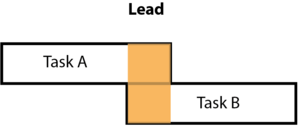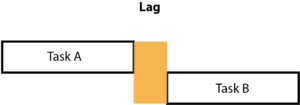Lag & Lead
Developed by Helene Waldmann Jørgensen
Abstract
A project manager oversees that the project finishes on time and therefore the project manager must keep the project on schedule. A heavy project delay is often seen as a project management failure, therefore keeping a project on schedule is important for the success of the project management team. This article will present the concept of Lag and Lead and how a project manager can use this actively to help scheduling and adjusting the scheduling during the project. Lag and Lead are used in the process of sequencing activities before the project starts. Task and activities are scheduled to take place at the same time or after each other. Using the concept of Lag and Lead task and activities can be scheduled to take place with the right overlap or time in between. A lead means an activity takes place while the previous is still going on and a lag means that there is a pause before an activity start after the previous have finish. Lag and lead are used in other different specific scheduling tools for example Critical Path Method and Network planning. Having an overview of the Lag and Lead needed between each task and activity means that project manager can optimize the schedule and know where to gain lost time to finish the project on time. There are some limitations with Lag and Lead as it is not a tool but rather a technique that is used in different tools.
Importance of Lag and Lead
As a project is only temporary endeavor[1] therefore there is a start and a finish date. In most cases the finish date is decided in the process of planning a project. When the project starts it is the project managers job to keep the project on schedule and avoid any major delays. A project that is done well but not done on time can be viewed as a project management failure, as the project did not fail but the management made mistakes as the project was not done on time. In the begin of a project the project management team will make a schedule for the project. There are different parts that goes into the making of a schedule. The parts include:
- Planning the Management Schedule[1]
- Defining the activities[1]
- Sequencing Activities[1]
- Estimate Activity Durations[1]
- Develop Schedule[1]

During the project the project management team will control the schedule as well[1]. Lag and Lead is part of Sequencing Activities. In the process of Sequencing Activities, the relationship between the activities in the project are identified and documented. The benefits from the process are the definition of the logical sequence of work to obtain the greatest efficiency given all the project constrain [1]. All activities in the project should be connected to a least one predecessor and at least one successor expect the first and last activity. Activities should be connected to another activity with an appropriate logical relationship. These logical relationships must be designed so a realistic project schedule can be created. To help create and support a realistic project schedule Lag and Lead are used in between activities. Sequencing Activities will take the list of activities and turn them into a diagram to act as a first step to publish the schedule baseline[1].

In Project Management: A guide to the Project Management Body of Knowledge lead is defined as “A lead is the amount of time a successor activity can be advanced with respect to a predecessor activity.”. The ISO standard ISO 21500 defines lead as “Attribute applied to a logical relationship to advance the start or end of an activity”. These two definitions are two ways of saying a lead set the amount of time an activity can start before the previous are finished. When using lead the two activities will be done in parallel during the lead time. Figure 1 shows an illustration of lead time.
There are also two definitions of Lag one from Project Management: A guide to the Project Management Body of Knowledge and one from the ISO 21500. The Project Management: A guide to the Project Management Body of Knowledge definition of lag is “A lag is the amount of time a successor activity will be delayed with respect to a predecessor activity.”[1]. The definition in the ISO 21500 of lag is “Attribute applied to a logical relationship to delay the start or end of an activity”. Again, this is two ways of defining the same thing, that Lag means an activity takes place a set amount of time after the previous. Lag should one be applied if there is logical reason for it. Figure 2 shows an illustration of lag time.